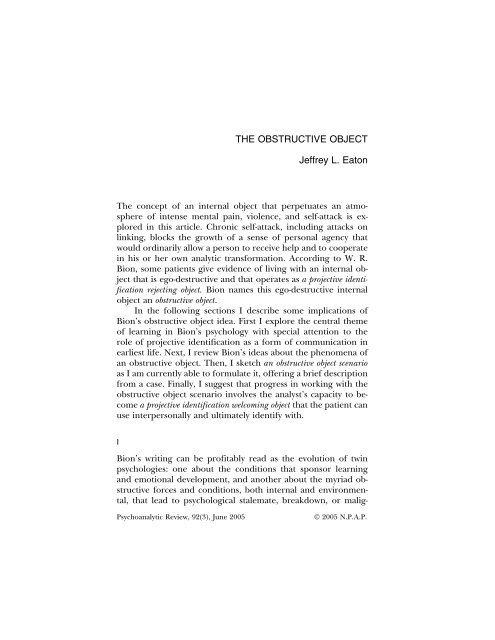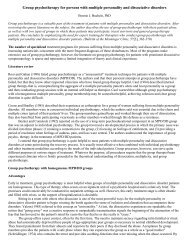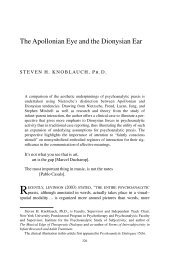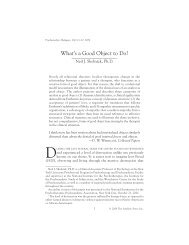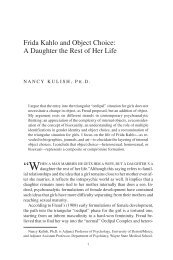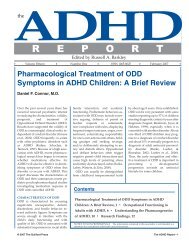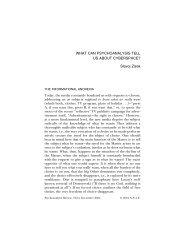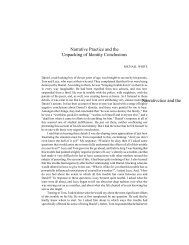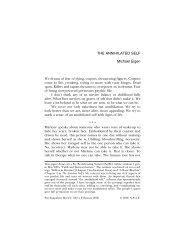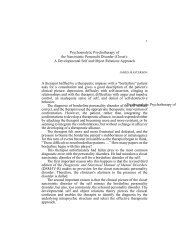THE OBSTRUCTIVE OBJECT Jeffrey L. Eaton - PsyBC
THE OBSTRUCTIVE OBJECT Jeffrey L. Eaton - PsyBC
THE OBSTRUCTIVE OBJECT Jeffrey L. Eaton - PsyBC
Create successful ePaper yourself
Turn your PDF publications into a flip-book with our unique Google optimized e-Paper software.
<strong>THE</strong> <strong>OBSTRUCTIVE</strong> <strong>OBJECT</strong><br />
<strong>Jeffrey</strong> L. <strong>Eaton</strong><br />
The concept of an internal object that perpetuates an atmosphere<br />
of intense mental pain, violence, and self-attack is explored<br />
in this article. Chronic self-attack, including attacks on<br />
linking, blocks the growth of a sense of personal agency that<br />
would ordinarily allow a person to receive help and to cooperate<br />
in his or her own analytic transformation. According to W. R.<br />
Bion, some patients give evidence of living with an internal object<br />
that is ego-destructive and that operates as a projective identification<br />
rejecting object. Bion names this ego-destructive internal<br />
object an obstructive object.<br />
In the following sections I describe some implications of<br />
Bion’s obstructive object idea. First I explore the central theme<br />
of learning in Bion’s psychology with special attention to the<br />
role of projective identification as a form of communication in<br />
earliest life. Next, I review Bion’s ideas about the phenomena of<br />
an obstructive object. Then, I sketch an obstructive object scenario<br />
as I am currently able to formulate it, offering a brief description<br />
from a case. Finally, I suggest that progress in working with the<br />
obstructive object scenario involves the analyst’s capacity to become<br />
a projective identification welcoming object that the patient can<br />
use interpersonally and ultimately identify with.<br />
I<br />
Bion’s writing can be profitably read as the evolution of twin<br />
psychologies: one about the conditions that sponsor learning<br />
and emotional development, and another about the myriad obstructive<br />
forces and conditions, both internal and environmental,<br />
that lead to psychological stalemate, breakdown, or malig-<br />
Psychoanalytic Review, 92(3), June 2005 © 2005 N.P.A.P.
356 JEFFREY L. EATON<br />
nant transformation. A tension between learning (in the widest<br />
sense the evolution of the mind) and obstruction to learning expands<br />
from Bion’s early group work all the way through his final<br />
papers.<br />
The roots of Bion’s interest in learning are no doubt to be<br />
found in his own autobiography. Such a study is beyond the<br />
scope of this article. However, even as a little boy Bion was a<br />
keen observer and a curious child. In his autobiography, The<br />
Long Weekend (1985), there are many moving vignettes about his<br />
curiosity, his sensitivity to his own emotional states as well as to<br />
those of others, his confusions over language, and his openness<br />
to impressions of all sorts.<br />
Bion’s war experience (beginning as a teenager) is a critical<br />
context for understanding the meaning that learning from experience<br />
came to have for him over the remainder of his deeply<br />
reflective life. He realized that groups can become anti-learning<br />
assemblages and that failing to learn (indeed failing to think) can<br />
be a matter of life and death. The anti-learning forces observable<br />
in groups can also be inferred in the individual personality.<br />
What I want to emphasize is that for Bion the theme of learning<br />
is not an academic one. Learning is about emotional experience.<br />
It can be detected in the movement from survival to creativity,<br />
from gathered information to personal realization, and from<br />
evacuative reaction to action mediated by reflective thought.<br />
Learning involves, in Bion’s terms, the individual’s relationship<br />
to the very fabric of life itself, attention (or its absence) to the<br />
emotional texture of truthful experience out which wisdom or<br />
folly springs.<br />
Bion explicitly distinguishes learning from experience from<br />
“learning about.” For example, I may learn about psychoanalysis<br />
by reading books, seeing films, and listening to others who have<br />
been in analysis share their experiences. These experiences allow<br />
me to gather information and to form impressions about which<br />
I may have strong feelings. I may even come to believe I know a<br />
great deal about psychoanalysis. However, such learning can in<br />
no way substitute for the experience of actually participating in<br />
psychoanalysis. These two kinds of knowing give rise to a personal<br />
“language of achievement” in contradistinction to “the language<br />
of substitution.” The mind, according to Bion, only grows
<strong>THE</strong> <strong>OBSTRUCTIVE</strong> <strong>OBJECT</strong> 357<br />
when nourished by contact with truthfulness. The task of maturation<br />
is to grow greater and greater capacity to explore experience<br />
and to become yet more truthful, to distinguish lies, and to<br />
make space to recognize the thoughts that are seeking a thinker.<br />
Experience, especially emotional experience, provides the building<br />
blocks of the mind.<br />
How does this process of learning from experience take<br />
place? Projective identification provides one model of what sponsors<br />
healthy emotional development and learning from experience<br />
in earliest life. Extending Klein’s work, Bion introduces the<br />
idea of normal projective identification as a form of communication<br />
between a baby and his or her mother (Bion, 1962, p. 37).<br />
The infant’s facial expressions, vocalizations, crying, and muscular<br />
gestures signal his or her distress. By distress I mean something<br />
familiar: raw emotional experience at the level of sensation<br />
that obtrudes upon the infant’s attention or awareness. This obtrusion<br />
may be of such intensity that it saturates the infant’s experience<br />
through states of sensory-dominated arousal. Bion gives<br />
this familiar human experience a very abstract name. He calls<br />
such primitive sensory or emotional distress “beta elements”<br />
(Bion, 1962, p. 6) According to Bion, beta elements are suitable<br />
only to be projected, or, as he says, evacuated. This word–evacuated—speaks<br />
to force and intensity.<br />
What is the fate of evacuated distress? Put more simply,<br />
what is the fate of the infant’s cry of pain? In order for distress<br />
to be transformed, Bion suggests that it must find a home in the<br />
mind of another. Ideally a mind can be found to register the<br />
infant’s pain. Still more important, that mind should belong to<br />
an individual more emotionally mature—someone with more experience<br />
of tolerating distress than the infant. If this is so, then<br />
pain can be more than registered, it can be recognized, reflected<br />
upon, and replied to creatively and compassionately.<br />
Bion asks the question: What does this other mind do for<br />
the infant in distress? Something helps the experience of raw<br />
emotional distress become an opportunity to evolve in the direction<br />
of discovering meaning. Bion says this something that helps<br />
is called “alpha function.” The discovery of meaning depends<br />
upon the mother’s ability to use her mind, including her attention,<br />
intuition, and emotional experience (all factors in her alpha
358 JEFFREY L. EATON<br />
function) to contain her infant’s distress (the beta elements) and<br />
to transform that distress imaginatively.<br />
In Bion’s abstract formulation beta elements are transformed<br />
into alpha elements. Alpha elements are, according to<br />
Bion, the building blocks of memory, dreams, and reflective awareness.<br />
The capacity to learn from experience (Bion, 1962) depends<br />
upon the growing ability to transform beta elements into<br />
alpha elements. This transformation is sponsored as the infant<br />
internalizes and identifies with the mother as a containing object<br />
capable of alpha function.<br />
According to Bion, an infant is dependent upon the actual<br />
separate mind of another in a particular way. The infant’s needs<br />
for food, safety, proximity, and for concrete care may be adequately<br />
provided for. Bion highlights another dimension of experience<br />
that he feels is an essential factor in the evolution of<br />
the infant’s mind. An infant also depends upon the quality of<br />
mother’s attention, and her capacity for reverie as a factor in<br />
alpha function. In short, the infant depends upon the unique<br />
qualities of the mother’s own internal object world expressed<br />
through the quality of her interactions with her baby. The quality<br />
of mother’s emotional presence helps her infant’s mind to be<br />
born and to grow emotionally.<br />
A mother sponsors the essential experience of transformation<br />
from beta to alpha, from distress to comfort, repeatedly.<br />
She picks her baby up, rocks him or her, sings to the baby, and<br />
speaks aloud about what might be troubling her infant. She<br />
allows her infant to disengage when overstimulated, and she reengages<br />
her infant when the latter’s gestures signal the desire to<br />
reconnect. The successful transformation of distress to comfort<br />
makes play and exploration possible. In essence, the mother uses<br />
her own intuition, unconscious memory of her own care as a<br />
child, and her emotional availability in the moment to investigate<br />
the experience of her infant and to reply to it.<br />
According to Bion, the capacity to learn from experience is<br />
characterized, in particular, by an ability to tolerate and transform<br />
rather than to evade the inevitable turbulence and frustration<br />
of uncertain and painful situations. It also involves a faith<br />
that in states of distress, including even acute distress, one will<br />
not become totally trapped in an atmosphere of emotional catas-
<strong>THE</strong> <strong>OBSTRUCTIVE</strong> <strong>OBJECT</strong> 359<br />
trophe. Instead, this faith, based on the accumulated memories<br />
of the mother’s repeated capacity to receive and transform distress<br />
into comfort, promotes a capacity for personal reverie, that<br />
is, a reverie for one’s own experience as it arises and is lived<br />
through. This capacity for personal reverie can be pictured as<br />
the self able to turn toward and rely upon internal projective identification<br />
welcoming objects that can bear the turbulence of a new<br />
experience and can sponsor openness toward learning and exploration.<br />
The capacity for transformation from distress to comfort<br />
is the basis for motivated initiative. It requires continued<br />
rejuvenation, from both internal and external support, and must<br />
be widened, expanded, and continually consolidated as new experiences<br />
pressure the mind to grow.<br />
II<br />
By observing the phenomena of the obstructive object a model<br />
can be developed for why learning from experience seems nearly<br />
impossible for some people. Bion (1993) introduces the term<br />
“obstructive object” in his “schizophrenia” papers, particularly in<br />
“On Arrogance” and “Theory of Thinking.” These papers, along<br />
with “Attacks on Linking” form the background for several passages<br />
from Learning from Experience that describe the consequences<br />
not only of a failure of maternal reverie and absent or<br />
inadequate alpha function, but also of the important variables of<br />
an excess of envy as well as very low frustration tolerance in the<br />
infant. Such a constellation of factors can contribute to severe<br />
vulnerability in the mother–infant dyad. Such vulnerability may<br />
inhibit or obstruct the development of the container/contained<br />
relationship over time and make faith in the reliable transformation<br />
of distress to comfort impossible to realize.<br />
The roots of the obstructive object are to be found in<br />
Klein’s work on splitting and the paranoid-schizoid position.<br />
Klein focuses on the development of psychic reality through the<br />
mechanisms of introjection and projection. According to Buckingham<br />
(2002), Klein theorized that<br />
Infants with an inherently low tolerance of frustration are likely<br />
to have phantasies of a bad, denying breast and will experience<br />
sadistic, attacking impulses towards it. This sets in train a negative
360 JEFFREY L. EATON<br />
cycle: fears of retribution, introjection of a bad, damaged breast,<br />
feelings of persecution which are projected back into the breast,<br />
and so on. Early disjunction between mother and baby can set in<br />
even if the mother is doing her best to counteract the baby’s anxiety.<br />
Another baby, with high tolerance of frustration, may thus<br />
fare better under worse external circumstances, although a baby<br />
whose mother is not in touch with her needs will suffer. (p. 107)<br />
A close reading of Bion finds him extending Klein’s work<br />
and carefully addressing the intersection of interpersonal and<br />
intrapsychic variables that may give rise to situations that he<br />
names infantile catastrophe and nameless dread. Bion suggests that<br />
for some patients distress is never reliably transformed and that<br />
dire consequences follow.<br />
In “Attacks on Linking” (Bion, 1993) Bion writes:<br />
Projective identification makes it possible for him to investigate<br />
his own feelings in a personality powerful enough to contain<br />
them. Denial of the use of this mechanism, either by the refusal<br />
of the mother to serve as a repository for the infant’s feelings, or<br />
by the hatred and envy of the patient who cannot allow the<br />
mother to exercise this function, leads to a destruction of the link<br />
between infant and breast and consequently to a severe disorder<br />
of the impulse to be curious on which all learning depends [emphasis<br />
added]. The way is therefore prepared for a severe arrest of<br />
development. Furthermore, thanks to a denial of the main method<br />
open to the infant for dealing with his too powerful emotions, the<br />
conduct of emotional life, in any case a severe problem, becomes<br />
intolerable. Feelings of hatred are thereupon directed against all<br />
emotions including hate itself, and against external reality which<br />
stimulates them. It is a short step from hatred of the emotions to<br />
hatred of life itself. (pp. 106–107)<br />
Here Bion is going a step beyond either Freud or Klein.<br />
Instead of posing the individual’s main conflict as arising between<br />
reality and fantasy or between love and hate or between<br />
the life instincts and the death instinct, Bion describes how some<br />
patients are faced with a choice between emotion and antiemotion.<br />
In the absence of maternal reverie or in the presence<br />
of excessive envy or frustration, hatred is directed toward emotional<br />
experience itself.<br />
A critical feature of the obstructive object relationship is<br />
that the person feels overwhelmed by emotional experience. According<br />
to the American Heritage Dictionary (1981), one meaning
<strong>THE</strong> <strong>OBSTRUCTIVE</strong> <strong>OBJECT</strong> 361<br />
of distress is “the condition of being in need of immediate assistance.”<br />
This definition seems to capture the experience of the<br />
infant who feels a desperate urgency for relief when raw emotional<br />
experience (beta elements) obtrudes upon awareness.<br />
Bion writes (1977): “If there are only beta-elements, which cannot<br />
be made unconscious, there can be no repression, suppression,<br />
or learning. This creates the impression that the patient is<br />
incapable of discrimination. He cannot be unaware of any single<br />
sensory stimulus: yet such hypersensitivity is not contact with reality”<br />
(p. 8).<br />
It is at this very moment of distress and vulnerability that a<br />
containing object is so desperately needed. What kind of object<br />
will be there to greet the infant’s distress? The obstructive object,<br />
as defined by Bion, is overwhelming in a quite particular<br />
way. An obstructive object is a projective identification rejecting object<br />
that has been internalized. Bion (1993) notes: “The (infant’s)<br />
rudimentary consciousness cannot carry the burden placed<br />
upon it (by the experience of uncontained distress). The establishment<br />
of a projective-identification-rejecting-object means that<br />
instead of an understanding object the infant has a willfully misunderstanding<br />
object—with which it is identified” (p. 117).<br />
I want to unpack Bion’s condensed language and try to<br />
bring closer to home what I think he intends to describe. What<br />
does a projective identification rejecting object look like and feel<br />
like? In infant observation or in clinical work with mothers and<br />
infants one can sometimes painfully observe the interpersonal<br />
origins of the obstructive object. Imagine, for example, an infant<br />
crying in her crib. Mother for some reason cannot bear her baby’s<br />
crying. She does not pick her baby up and try to soothe her.<br />
Instead, she leaves the room, perhaps shutting the door to muffle<br />
her baby’s cries. This is a literal description of a scenario<br />
where the baby’s distress is rejected. Bion suggests that this sort<br />
of scenario leaves the baby in a state of potentially unmodified<br />
distress. Drawing on the experience of infant observation I can<br />
speculate about the sorts of experiences that a baby might have<br />
after its projective identification of distress has been rejected.<br />
Suppose that one could observe this baby now left alone in its<br />
crib. Perhaps the infant will cry until exhausted and then “withdraw”<br />
into sleep. Perhaps she will adhesively identify with a pat-
362 JEFFREY L. EATON<br />
tern on the curtain or a shadow on the wall as a way of fixing<br />
her attention and subjectively pulling herself together. Perhaps<br />
we can imagine her finding her thumb, putting it into her<br />
mouth, sucking, and in this way gradually calming. Perhaps she<br />
will become muscularly tense and rigid, curling her toes, making<br />
her fingers into fists, stiffening her neck and arching her back,<br />
and finally settling into a different state. Now imagine that this<br />
scenario is repeated many times over several weeks or months<br />
without variation. A great deal depends, of course, on the complexity<br />
of the patterns of communication and rejection that are<br />
unfolding, evolving, or reifying between mother and baby over<br />
time. Somehow these patterns become unconsciously represented<br />
by both partners in terms of unconscious relational expectations<br />
(Beebe & Lachmann, 2002).<br />
It is from a scenario of this sort that one can begin to appreciate<br />
what an obstructive object scenario looks like and feels<br />
like. My contention is that an obstructive object scenario is a<br />
more extreme and chronic outcome of the repeated experience<br />
of meeting the other as a projective identification rejecting object.<br />
I want to be clear that I think the creation of the obstructive<br />
object scenario involves vulnerability at both the intrapsychic<br />
and the interpersonal levels of experience. This scenario takes<br />
different forms with varying intensities for different patients.<br />
For the sake of brevity I want to simplify the situation to its essentials.<br />
The obstructive object relationship, according to Bion,<br />
is “willfully misunderstanding.” I am interested in conveying the<br />
feel of this kind of “link.”<br />
Imagine, now, a mother who cannot stand her infant’s crying.<br />
She feels, for her own unconscious reasons, that her infant<br />
is doing something to her by crying out in distress. This mother<br />
cannot bear what feels too overwhelming. She screams at her<br />
infant to shut up. Maybe she shakes her infant to silence her. In<br />
the worst of all scenarios she suffocates her infant with a pillow<br />
to silence her. An obstructive object is experienced as someone or something<br />
actively hostile toward emotional experience, creating an atmosphere<br />
of escalating pressure and violence. Though it is beyond the<br />
scope of this article to describe, it is my experience that the obstructive<br />
object scenario is created anew again and again over<br />
generations.
<strong>THE</strong> <strong>OBSTRUCTIVE</strong> <strong>OBJECT</strong> 363<br />
Another way to picture the obstructive object is by turning<br />
to myth. For example, following Bion, the figure of the Sphinx<br />
is emblematic of an obstructive object. When we remember the<br />
Sphinx we remember a monster. She is part woman, part lion,<br />
and part bird. We also remember her riddle. What is much more<br />
important than the content of her riddle, however, is the emotionally<br />
violent atmosphere evoked when the Sphinx stops Oedipus<br />
from continuing on his journey. There is an atmosphere of<br />
intense threat, confusion, and hatred. The Sphinx is not felt to<br />
be asking riddles playfully, or in the service of learning, but in<br />
a bizarre and violent manner, as weapons to attack links and<br />
thinking.<br />
Recall the images from the Oedipus myth. The Sphinx<br />
blocks the road to Thebes, stopping everyone who wishes to enter.<br />
She demands that they answer a riddle in order to pass. She<br />
threatens people by saying that if they answer her wrongly they<br />
will die. The obstructive object sponsors an atmosphere of confusion<br />
and terror. The subject is faced with a unconscious choice<br />
between omnipotence or helpless collapse. This dire choice is<br />
symbolized by the Sphinx’s own suicide when Oedipus guesses a<br />
plausible answer to the riddle. One is left in an atmosphere of<br />
horror.<br />
With these images in mind one can begin to observe a certain<br />
category of phenomena in the consulting room that superficially<br />
appear to be motivated by destructive impulses. It is very<br />
important to differentiate the consequences of violent projections,<br />
which are, indeed, often destructive, from their motivation,<br />
which may be very different. The intensity and pervasiveness<br />
of some forms of violent projection may be part of an unconsciously<br />
frantic search for a helping object that can transform pain and<br />
distress into comfort. If relief is not adequately found, the violence<br />
of the projection intensifies. Such constant and intense projections<br />
then may serve multiple simultaneous functions. The projection<br />
may serve to rid pain through evacuation; it may serve to<br />
communicate distress still more emphatically; it may serve to try<br />
to control an object through an invasive fantasy, what Klein originally<br />
called excessive projective identification. Or it may serve<br />
to destroy the mental apparatus through a process described by<br />
Bion as “attacks on links.” Since none of these functions can
364 JEFFREY L. EATON<br />
lead to an adequate transformation of distress into comfort, the<br />
self is faced with overwhelming emotional experiences that over<br />
time produce an atmosphere of intense, ego-destructive dread.<br />
Bion (1993) gives this description from his own clinical<br />
work in his essay “Attacks on Linking”:<br />
III<br />
Associations from a period in the analysis ...showed an increasing<br />
intensity of emotions in the patient. This originated in what<br />
he felt was my refusal to accept parts of his personality. Consequently<br />
he strove to force them into me with increased desperation<br />
and violence. His behaviour, isolated from the context of<br />
the analysis, might have appeared to be an expression of primary<br />
aggression. The more violent his phantasies of projective identification,<br />
the more frightened he became of me. There were sessions<br />
in which such behaviour expressed unprovoked aggression,<br />
but I quote this ...because it shows the patient in a different<br />
light, his violence a reaction to what he felt was my hostile defensiveness.<br />
(p. 104)<br />
Over the past several years I have tried to observe what might<br />
be called an obstructive object scenario in my clinical work with<br />
children and adults. One feature I have noticed is the phenomenon<br />
of constant and intense projection as a crucial function in<br />
perpetuating the overwhelming aspect of the obstructive object.<br />
Often we think of projective identification arising as a discrete<br />
response to an overwhelmingly intense experience. However, in<br />
my experience, some patients rely upon a kind of pervasive projective<br />
identification. Because distress cannot be transformed<br />
into comfort, some people act as if their minds have become<br />
machines for evacuation. Constant and intense projections blur<br />
the already tenuous boundary between self and other. This pervasive<br />
projection creates an atmosphere of confusion, hostility,<br />
and agitated frustration because intense distress is felt to be always<br />
already present everywhere.<br />
I have learned much about the obstructive object scenario by<br />
working with a patient I here call Paula. Paula is a middle-aged<br />
woman who feels unable to sustain a loving sexual relationship<br />
with a man over time. She feels unable to complete her professional<br />
and educational ambitions, and unable to earn a satisfac-
<strong>THE</strong> <strong>OBSTRUCTIVE</strong> <strong>OBJECT</strong> 365<br />
tory income. She is highly intelligent but blocked in her capacity<br />
to learn from experience. She says she has no confidence in herself.<br />
Until recently she had given little thought to her future.<br />
Upon entering analysis Paula characterized her daily experience<br />
as “scattered,” “foggy,” and “dreamlike.” Now, nearly four<br />
years into our work together, she is able to observe how she<br />
“constantly distracts herself from the moment.” She now reports<br />
finding some sense of being able to “be clear” and “to think<br />
straight.” Paula still seems to oscillate between states of hyperarousal<br />
(sometimes reaching a level of panic) and hypoarousal<br />
(feeling exhausted, depressed, and sometimes overwhelmed with<br />
despair). She is still often exhausted by what feels to her like an<br />
unrelenting, assaulting present from which she cannot escape.<br />
Paula’s early sessions were filled with fragmented descriptions<br />
of her feelings of deep rage and disturbance about the<br />
many atrocities occurring throughout the world. Paula seemed<br />
to repeat the same fragmented stories, often in detail, as if she<br />
had never seen me before or as if she could not believe I was<br />
listening to her or remembering our meetings.<br />
Very quickly I began to wonder if Paula could listen to me.<br />
Things I said seemed to be willfully ignored. Paula felt intensely<br />
disturbed by what she said was evidence of the corruption of the<br />
Bush administration. She also felt persecuted by the men in charge<br />
at her workplace. I understood these complaints at one level as<br />
a gathering of the transference, but Paula rejected transference<br />
interpretations as formulaic and “psychoanalytic bullshit.” Paula<br />
insisted on the merit of her concrete concerns, especially of the<br />
shared social situation we were both living through.<br />
I often felt intimidated, rejected, angry, and exhausted in<br />
the face of Paula’s tirades. Her seeming unwillingness to accept<br />
my sincere attempts at understanding began to wear me down<br />
day after day. Over time she became worried that I could not<br />
see or acknowledge her worries about “the real world.” She implied<br />
that I was the one who needed analysis and that I was ill<br />
because I could not acknowledge reality.<br />
Eventually I began to recognize that Paula might unconsciously<br />
experience every emotional relationship as an obstructive<br />
object scenario. I began to discern that I might be enacting<br />
a role that seemed to feel to Paula like a projective identification
366 JEFFREY L. EATON<br />
rejecting object. Through self-analysis and supervision I tried to<br />
open up my way of thinking about and being with Paula in order<br />
to be more at-one with her picture of the world. I realized that<br />
Paula seemed to believe that I was a willfully misunderstanding<br />
object trying to force my illness into her.<br />
With many patients I often experience a greater or lesser<br />
degree of what I regard as reverie. By reverie I mean an openness<br />
and freedom to listen to myself listening to the patient (Grotstein,<br />
personal communication, 2003). In any given session the emotional<br />
experience of being with a patient may evoke sensations,<br />
images, memories, reflections, or sudden intuitive “hunches”<br />
that can become part of the material that eventually forms an<br />
interpretation. The capacity for reverie sponsors a kind of inquiry<br />
into and spontaneous description of the emotional field<br />
arising between patient and analyst in the moment. With Paula<br />
I felt little freedom to speak, much less to dream the session. I<br />
felt little freedom to let my mind relax, wander, or play. Instead,<br />
I often felt “on the edge of my seat” (sometimes literally) because<br />
of the tension in the room. I expected Paula to explode,<br />
and sometimes she did.<br />
The question, I think, that faced me with Paula was how to<br />
be in two places simultaneously. Paula seemed to regard me as<br />
the embodiment of an willfully misunderstanding object, amplifying<br />
her distress with my apparently cruel and stupid interpretations.<br />
I had to find some way to accept this reality in the transference.<br />
At the same time, I began to ask myself how I could<br />
become the opposite of an obstructive object, a projective identification<br />
welcoming object. How could I do this in a way that<br />
would feel real to Paula? How could I find a place in myself<br />
where I could tolerate the distress aroused in me by being with<br />
Paula? I had to try to find my way toward my own projective<br />
identification welcoming objects in order to tolerate, contain,<br />
and transform my own significant distress so that a space of reverie<br />
might become tenuously possible. I intend to offer a fuller<br />
description of this process in a future articles. For now, I think<br />
the key point is the idea that working through in the countertransference<br />
involves repeatedly reestablishing and contacting<br />
the vitality of one’s own projective identification welcoming objects<br />
rather than giving in to the temptation to “slam the door”
<strong>THE</strong> <strong>OBSTRUCTIVE</strong> <strong>OBJECT</strong> 367<br />
on the potential of living through and transforming both the<br />
analyst’s and the patient’s distress. Each of us has to find our<br />
own ways, through experience, to make this kind of opening up<br />
to pain possible. The personal obstacles to allowing this kind of<br />
development can be significant indeed.<br />
IV<br />
How does an infant realize a mother’s reverie? I suggest that the<br />
mother in reverie helps to facilitate a transformation that in its<br />
most primitive form is subjectively registered by the infant as<br />
moving from bodily distress to bodily comfort. In the actual beginning<br />
of the infant’s life, the transformation from beta elements<br />
to alpha elements involves a feeling of somatic relief. Before<br />
the infant has the capacity to represent this transformation<br />
in organized images, I suggest that the infant experiences the<br />
“shape” of this transformation in bodily experiences of calming<br />
and relaxation. The capacity of the infant to become calm after a<br />
state of anxious arousal is, I suggest, one of the earliest and most<br />
important transformations repeatedly facilitated by a mother in<br />
reverie. It may be that this first transformation is already developing<br />
in fetal life. Whenever it occurs, I name this transformation,<br />
descriptively, a transformation from distress to comfort.<br />
An infant able to receive and use a mother’s reverie is able<br />
gradually to experience psychical qualities, whereas an infant for<br />
some reason deprived of the benefit of reverie may remain<br />
trapped within the intensity and concreteness of distress. A projective<br />
identification welcoming object promotes the recognition of<br />
psychical experience and a space for thinking, while a projective<br />
identification rejecting object leads to a denial, even hatred of<br />
psychic reality. A projective identification welcoming object is<br />
the basis for the establishment of the evolving relationship between<br />
container and contained that promotes the transformation<br />
of distress to comfort.<br />
The mother’s capacity for reverie and her ability to lend her<br />
alpha function to her infant’s state of distress is a comfort that<br />
strengthens her infant’s developing mind through the creation<br />
of alpha elements that eventually make the comprehension of<br />
meaningful emotional experience possible. The provision of alpha
368 JEFFREY L. EATON<br />
function provides not only relief, but the possibility of a new<br />
experience, a novel and evolving relationship to distress that<br />
over the process of maturation becomes represented in more<br />
and more sophisticated ways. Also at stake is the fate of attention.<br />
The infant trapped in distress dissociates its attention from<br />
more and more experience, while an infant capable of the transformation<br />
from distress to comfort establishes a curious link to<br />
other objects and is free to explore experience.<br />
My challenge was to find a way to make real for Paula the<br />
experience of this earliest transformation from distress to comfort<br />
in order to help her mind to grow free to learn from emotional<br />
experience. Somehow, as I have said, I had to free my<br />
own mind to allow more room for observation, reverie, play, and<br />
exploration. So, what did I do? First, I began to slow down, to<br />
say less, and to try to be at-one with Paula’s experience rather<br />
than trying to describe something about the transference between<br />
us. This seemed to help. Gradually the atmosphere of the<br />
sessions began to change. Paula’s complaints came nearer to<br />
home, and focused upon her parents and siblings. Why should<br />
this be so? It seems to me that I was literally making space for<br />
Paula’s distress to exist, in her, within me, and between us. Before<br />
it could be transformed, spaces had to be discovered where<br />
her distress could be tolerated. During this time Paula began to<br />
describe that she could feel her distress was really registered by<br />
me and that this felt like a disorientingly new experience.<br />
Over time, Paula began to bring more dreams. Some of her<br />
dreams were horrific. Her dreams began to picture intensely<br />
shaming objects, both male and female. These objects were not<br />
only willfully misunderstanding, but creul and annihilating. My<br />
sense is that our work allowed the obstructive object to begin to<br />
take shape in her dream life so that we could begin to face it<br />
together. For reasons of confidentiality I am not reporting Paula’s<br />
dreams. However, I will share the dream of another patient<br />
because it so beautifully pictures the movement from the domination<br />
of the obstructive object to the tentative discovery of a<br />
projective identification welcoming object:<br />
A small figure approaches a larger figure. The small figure carries<br />
in her arms a large red-hot burning coal. The coal has burned
<strong>THE</strong> <strong>OBSTRUCTIVE</strong> <strong>OBJECT</strong> 369<br />
away the hands and arms of the small figure up to the elbows.<br />
The small figure desperately wants to pass the coal to the larger<br />
figure but is afraid of injuring the larger figure and of how the<br />
larger figure will react.<br />
This dream poignantly illustrates the awakening of a search<br />
for a projective identification welcoming object. This dream<br />
beautifully pictures the experience of raw emotional distress.<br />
The red-hot coal represents emotional intensity that is too searing<br />
to bear. A passage from John Lampen (1987), a Quaker essayist,<br />
gives imaginative voice to the small figure of this dream.<br />
This is the sort of thing I think patients can begin to put into<br />
words when they feel in touch with a projective identification<br />
welcoming object:<br />
I need you to take this great lump of pain which I feel ...Iwant<br />
you to look at it, and feel it, and think about it. Perhaps you can<br />
blunt some of its edges, soften it a little with your tears, or throw<br />
it up in the air and catch it to show me it is not so heavy as I<br />
thought. Perhaps you can take a measure and show me its proper<br />
size. Perhaps you could just hold it a little, while I get back on my<br />
feet again. But then you should give it back to me, because it is<br />
my load and my task. You may carry away a little of the poison,<br />
but the real task of making it safe can only be done by me. (p. 29)<br />
The discovery of a projective identification welcoming object<br />
sponsors the yearning to live and experience and to learn<br />
despite intense suffering. Paula has begun to express a tentative<br />
but powerful sense of being in love with love. This love is so<br />
fragile and so painful that it hurts to acknowledge it. She describes<br />
not only being terrified of an objectively dangerous and<br />
brutal world outside, but, even more to the point, of a loss of<br />
the sense of emerging preciousness of experience when the old<br />
persecutory relationship within herself reappears. All of Paula’s<br />
critiques of “the real world” apparently serve as screens to deflect<br />
our attention from her terrible anxiety of being someone<br />
who hates and fears her own emotional experience while at the<br />
same time desperately yearning to be more open to experience.<br />
Paula’s sense of humor has been of immense help to us<br />
both. She has a kind of gallows humor that makes space to face<br />
the immense pain of her life. She has begun to be interested in
370 JEFFREY L. EATON<br />
spiritual questions and even begun to wonder about the meaning<br />
of her life in ways that she had never engaged before. Analysis<br />
seems to be helping Paula to begin to symbolize her experience,<br />
particularly the presence of the cruel obstructive object.<br />
Recognizing and facing this cruel obstructive object seems sometimes<br />
unbearably intimidating. What has been especially important<br />
to us both has been the growing capacity for compassion<br />
that seems to arise as space is made to observe and describe the<br />
ways that Paula’s psychic reality is structured around approaching<br />
and withdrawing from the violent internal projective identification<br />
rejecting object. The more that I can clearly and emotionally<br />
describe this situation, the more I gradually earn Paula’s<br />
tentative trust. We have both begun to experience a kind of living<br />
through hell together. It seems that I must experience the feelings<br />
of rage, frustration, hopelessness, and helplessness that<br />
emerge while trying to think and experience in the presence of<br />
an obstructive object. Being more at-one with Paula’s experience<br />
is necessary in order to really begin to find words that feel truthful<br />
to her and that can hold her attention and reorient her to a<br />
new kind of relationship.<br />
CONCLUDING THOUGHTS<br />
This article has suggested that one of the most painful situations<br />
in analytic work involves the obstructive object relationship first<br />
described by Bion. The practical task of psychoanalysis is to identify,<br />
describe, and over time to transform the unconscious modes<br />
of coping with pain that were learned very early in life and that<br />
can be observed in transferences into the present. Our task is to<br />
learn to describe (and in doing so, contain and bring awareness<br />
to) the shifting levels of pain and anxiety that the patient experiences,<br />
moment to moment and session to session. Over time,<br />
the mindfulness and reverie that we demonstrate for our patient<br />
is internalized and becomes part of the patient’s own projective<br />
identification welcoming object world. These more creative internal<br />
object relationships can be increasingly relied upon to<br />
sponsor learning from experience over the course of a lifetime.<br />
There are particular challenges in working with obstructive
<strong>THE</strong> <strong>OBSTRUCTIVE</strong> <strong>OBJECT</strong> 371<br />
object scenarios. Patients block introjection of the therapist’s<br />
alpha function because of their own pervasive projective identification.<br />
They anticipate rejection and attack because they are<br />
identified with an ego-destructive internal object. The analyst<br />
has the large challenge of bearing the strain of the Sphinx-like<br />
encounter with terror and dread that the patient experiences<br />
upon emerging into an obstructive object transference that often<br />
has been deeply split off and denied. By avoiding the trap of<br />
concretely enacting a projective identification rejecting object,<br />
the analyst, through actual reverie and presence with the patient,<br />
gives the patient an experience that stimulates his or her own<br />
alpha function and in the best situations allows mourning and<br />
the working through of depressive anxieties to take place. This<br />
sponsors the reclamation of attention and thwarted life instincts<br />
that may now revive and expand by relying upon the new experience<br />
of a projective identification welcoming object and a sense<br />
of relationship to one’s own internal world. Through successful<br />
analytic work one can observe how the patient withdraws his or<br />
her projections from external objects back into him- or herself<br />
and his or her internal objects. This process happens as the patient<br />
begins to discover the analyst as a containing object, one<br />
who welcomes projective identifications rather than rejecting them,<br />
as anticipated by the patient.<br />
ACKNOWLEDGMENTS<br />
Several people have read and commented on this article as it<br />
was being written. I am grateful to each of them. Paul Cooper,<br />
Mike Eigen, and Robert Oelsner made extensive and helpful<br />
comments to the final drafts.<br />
REFERENCES<br />
Beebe, B., & Lachmann, F. (2002). Infant research and adult treatment: Coconstructing<br />
interactions. Hillsdale, NJ: Analytic Press.<br />
Bion, W. R. (1962). Learning From experience. London: Heimann.<br />
(1977). Seven servants: Four works by W. R. Bion. New York: Aronson.
372 JEFFREY L. EATON<br />
(1985). The long weekend: Part of a life and all my sins remembered. London:<br />
Karnac.<br />
(1993). Second thoughts. Northvale, NJ: Aronson.<br />
Buckingham, L. (2002). The hazards of curiosity: A Kleinian perspective on<br />
learning. In D. Barford, ed., The ship of thought: Essays on psychoanalysis and<br />
learning (pp. 106–135). London: Karnac.<br />
Lampen, J. (1987). Mending hurt: Swarthmore lecture. London: Quaker Home<br />
Services.<br />
619 North 35th Street<br />
Suite 206<br />
Seattle, WA 98103<br />
jleaton@nwlink.com<br />
The Psychoanalytic Review<br />
Vol. 92, No. 3, June 2005


